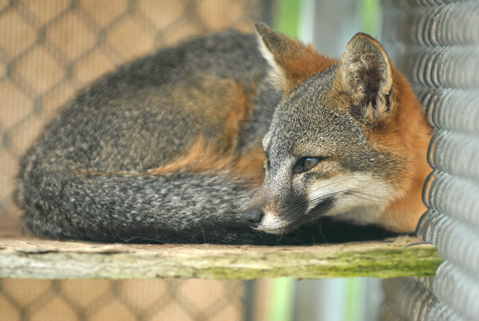Island Fox Back from the Brink
Likely the Fastest Revival of Any Endangered Species

After a near brush with extinction at the end of the 20th century, the island fox no longer is an endangered species on Santa Cruz and the other northern Channel Islands, the U.S. Fish and Wildlife Service announced this week. It’s believed to be the fastest ever recovery of an endangered species, and comes four years ahead of projections, thanks in part to the efforts of volunteers.
“I think people in Santa Barbara and beyond should be extremely proud of the efforts to recover the fox,” said Steve Henry, Field Supervisor for the wildlife agency. “This is a very charismatic species, and now you can go out to the islands, Santa Cruz in particular, and readily see the island fox. What the conservation community has done to preserve this species is nothing short of tremendous.”
According to the recovery plan released in March of last year, the effort by a consortium of agencies, conservationists, and volunteers has cost government agencies and conservation groups over $8 million.
The work began on a crisis basis, before the U.S. Fish and Wildlife Service could formally declare the fox an endangered species. That process — which requires extensive research and documentation — took five years. The fox was declared an endangered species on six islands in 2004, but that was five years after biologists saw a 90 percent die-off of the foxes on Catalina Island and nearly as serious a population drop on the northern islands.
When biologists with the Institute for Wildlife Studies (IWS) saw the catastrophic die-off on Catalina, they helped form a working group of biologists, conservationists, and volunteers. Using necropsies (autopsies), veterinarians quickly identified a disease that usually targets dogs — canine distemper virus — as the killer. A captive breeding program was launched in 1999, funded by the Catalina Island Conservancy. Before release, all the foxes were vaccinated against the distemper virus. Today the wildlife service estimates that there are over 1,800 foxes on Catalina.
The foxes on Santa Cruz Island have rebounded almost as spectacularly, now that their aerial nemesis — the golden eagle — has been removed from the islands. Today Tim Coonan, a wildlife biologist, estimates that there are at least 1,300 foxes on Santa Cruz Island, up from a mere 55 in l999.
At about the same time biologists on Catalina discovered the fox was threatened by a virus, biologists on the northern islands discovered that the island fox faced a different threat. Golden eagles had taken up residence in the northern islands and began picking off foxes from the air.
Golden eagles are not native to the Channel Islands. In times past, they had been kept out of the islands due to the presence of larger bald eagles, which feed on fish and carrion and which do not coexist with golden eagles. After the island’s bald eagle population was wiped out by high concentrations of DDT in ocean waters, the golden eagles found an empty ecological niche on the islands, took up residence, and thrived, devastating the population of foxes on the northern islands.
A captive breeding program was established on the three northern islands, and the remaining wild foxes on San Miguel, Santa Cruz, and Santa Rosa Islands — totaling less than 100 in number — were all put in roofed pens to protect them from the eagles and increase their numbers.
Meanwhile the National Park Service launched an effort to trap and remove golden eagles from the islands and relocate them to the far northern reaches of the Sierra Nevada Mountains. Using traps and net guns fired from helicopters, the service safely relocated 44 golden eagles from Santa Rosa and Santa Cruz Islands to the Sierras. With radio-tracking devices, the agencies made sure that the eagles did not return, and they have not seen foxes killed by eagles on the islands since 2008.
Although the islands have been hit hard by the drought, now entering its fifth year, biologist Henry said the foxes have been resilient, and are not expected to suffer ill effects.
Yvonne Menard, a spokesperson for the National Park Service, added that 225 fox pups have been born in the captive breeding program, which was discontinued as the populations stabilized and rebounded.
“We had over 300 volunteers in the program over that period of time,” she said, mentioning scientists, veterinarians, and field workers. “The contributions we have seen have been incredible.”



